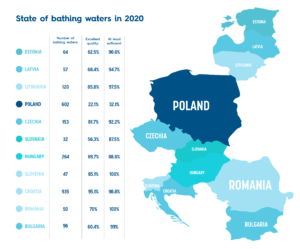These are Central Europe’s Cleanest Beaches
Reading Time: 3 minutesAre you planning your summer holidays in Central & Eastern Europe? If you’ll take your rest and relaxation at a beach in the region, we invite you to check the quality of the bathing water you’re planning on dipping into, whether it’s a lake or at the sea. We have analyzed the water cleanliness results in our region just for you.
Going to beaches is part of most Europeans’ summer plans. To support your selection of the beach you plan on visiting, every year in a joint effort with national authorities the European Union publishes its bathing water quality report. For summer of 2021, the report is based on water analysis results from 2020 – that’s why it still includes lakes and seaside beaches in the UK.
From the Baltics to the south of the Balkans, we at the Central European Times have carefully checked all of the results from countries in Central & Eastern Europe to give you a summary of the results.

The whole report is based on an assessment of 22,276 water samples from across all member states in the European Union. Our focus was trained on bathing water measurements from 11 countries in the region, namely: Bulgaria (96 taken), Croatia (935), Czechia (153), Estonia (64), Hungary (264), Latvia (57), Lithuania (120), Poland (602), Romania (50), Slovakia (32), Slovenia (47) – totaling 2,466 water quality samples.
The results show that Croatia not only has the best bathing waters in the CEE region with 95.8% of the samples exhibiting excellent quality and 98.9% at least sufficient water quality, but it also had the largest sample size with 998 waters tested. On the other end of the scale, Poland has not only the region’s but the whole EU’s lowest quality bathing waters. Based on 606 Polish water samples, only 22.1 % of them are excellent and 32.1 % are of sufficient quality.
Meanwhile, as a whole, the three Baltic countries have 241 bathing water samples tested. Lithuania had the best results with 103 excellent quality bathing water beaches, followed by Estonia with 40, and Latvia with 39 beaches with excellent quality water.
On the Adriatic coast, Croatia can boast the best seaside water quality as its results surpass those of Albania, Italy and Slovenia.
It’s important to notice though that some Eastern European countries – among them Romania, Slovakia, and to some extent Slovenia, submit relatively few samples compared to similar-sized Western European EU member states.
The good news is that since the EU introduced the European Bathing Water Directive in 1976, a number of positive developments have taken place around the continent. The share of coastal or lake beaches with excellent water quality in Europe has increased from 53% in 1991 to 85% in 2019.
Historically, across Europe and many other parts of the world, the quality of coastal waters, rivers and lakes generally degraded from the 19th century onwards, mainly because of growing towns and industries discharging untreated wastewater. During the 20th century, the increased use of pesticides and fertilizers on agricultural land added to that pollution.
Today, however, thanks to the efforts of governments and local authorities, bathing water quality across Europe has dramatically improved. Another positive development is that safe bathing is even possible today in several European capitals, among them Amsterdam, Berlin, Budapest, Copenhagen, London, Riga and Vienna.
Regardless of where you’re planning to cool down or swim, you can check the water quality results of the exact beach you plan on visiting in the interactive map below.
Interactive Online map

